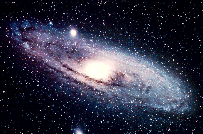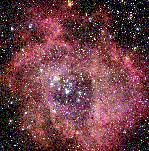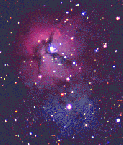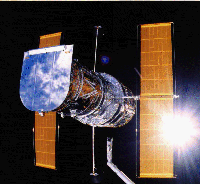





Astronomical Imaging: These are but a few examples of how astronomical pictures convey information about distant objects in the Universe. Click on any of these pictures to learn more about the object shown and what the picture tells us.
So if light is the only thing we have to work with, what can we do with it? One obvious
thing is that we can take "pictures" of the things we see. We are all familiar with
the many beautiful pictures of star clusters, nebulas, and galaxies that have been taken
with optical light and ground-based telescopes. Several examples are shown above. In
many cases, these pictures are awe-inspiring and they certainly convey information to
a trained eye. For instance, in the picture on the right (above), the diffuse pink
glow arises from hydrogen gas that is excited by hot stars in the gas; the diffuse blue glow,
on the other hand, is a dusty region that is scattering nearby star light into our direction.
Pictures alone, though, tend to
lack the "quantitative" aspect that is needed for most serious scientific studies.
For that, one needs to perform photometry, which is the technique
that measures the relative amounts
of light in different "colors" or wavelength ranges. However, the technique of
light analysis that produces the most detailed
information about objects in astronomy is called spectroscopy,
that is, breaking the light up into a spectrum which can then be analyzed for all
sorts of information.
Over the last 20 years or so, electronic light detectors have been developed that
permit astronomers to essentially combine photometry with either imaging or spectroscopy.
Electronic detectors, such as charge-coupled devices, or CCDs for short,
have now displaced photographic materials at most astronomical
observatories. These light detectors have the advantages of greater sensitivity,
a more quantitative response to the light they measure, and they produce data that
can be recorded digitally and entered directly into a computer for processing and
analysis. Taking electronic images with certain optical filters in place essentially
permits astronomers to perform imaging and photometry at the same time.
CCDs are now also widely in use in digital cameras and video cameras, and even advanced
amateur astronomers these days often have CCD cameras for their telescopes!
Likewise, recording a spectrum electronically (and making certain supporting
observations) lets astronomers combine spectroscopy and photometry into a powerful new
tool called spectrophotometry (that is, measuring how much light an object
produces at various wavelengths of light).
 The Hubble Space Telescope being deployed from the Space Shuttle, April 1990.
Since Hubble is above the atmosphere, it can obtain a clear view of the Universe, in
optical, ultraviolet, and near-infrared wavelengths. Hubble contains multiple
instruments, including both cameras and spectrographs. (While you see mainly the
photos from Hubble in the newspapers and magazines, much of the scientific work
performed by astronomers using Hubble is done with the spectrographs!)
The Hubble Space Telescope being deployed from the Space Shuttle, April 1990.
Since Hubble is above the atmosphere, it can obtain a clear view of the Universe, in
optical, ultraviolet, and near-infrared wavelengths. Hubble contains multiple
instruments, including both cameras and spectrographs. (While you see mainly the
photos from Hubble in the newspapers and magazines, much of the scientific work
performed by astronomers using Hubble is done with the spectrographs!)
The other big development over the last several decades is the ability to get telescopes
in orbit. Some of these satellite-telescopes take pictures or obtain spectra in
portions of the electromagnetic spectrum that don't get through the atmosphere, like
X-rays or ultraviolet light. Other telescopes, like the
Hubble Space Telescope (see above),take
advantage of their position above the atmosphere to obtain clearer and sharper views
than usually obtainable from the ground. (Hubble observes in both optical and
ultraviolet light, and even into the near infrared region.) The data from these
telescopes show familiar objects in new and different ways.
Click here to go to next section.
Return to Spectroscopy Home Page.
Bill Blair ([email protected])